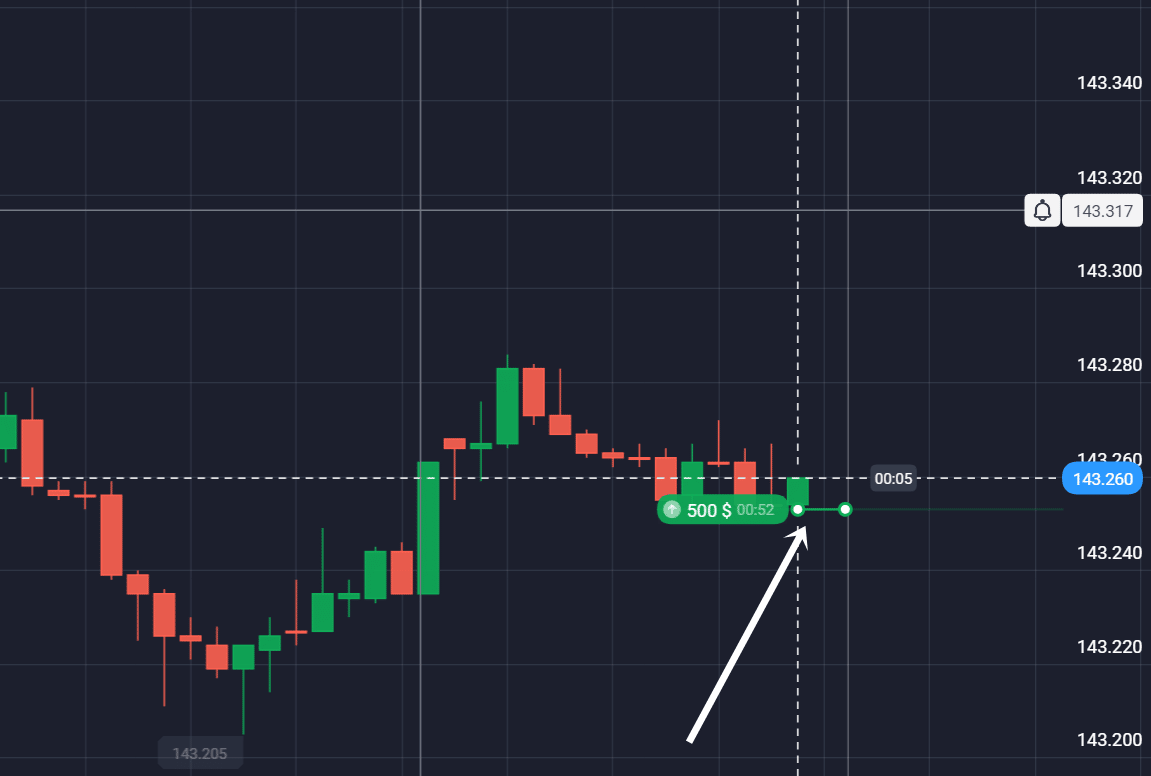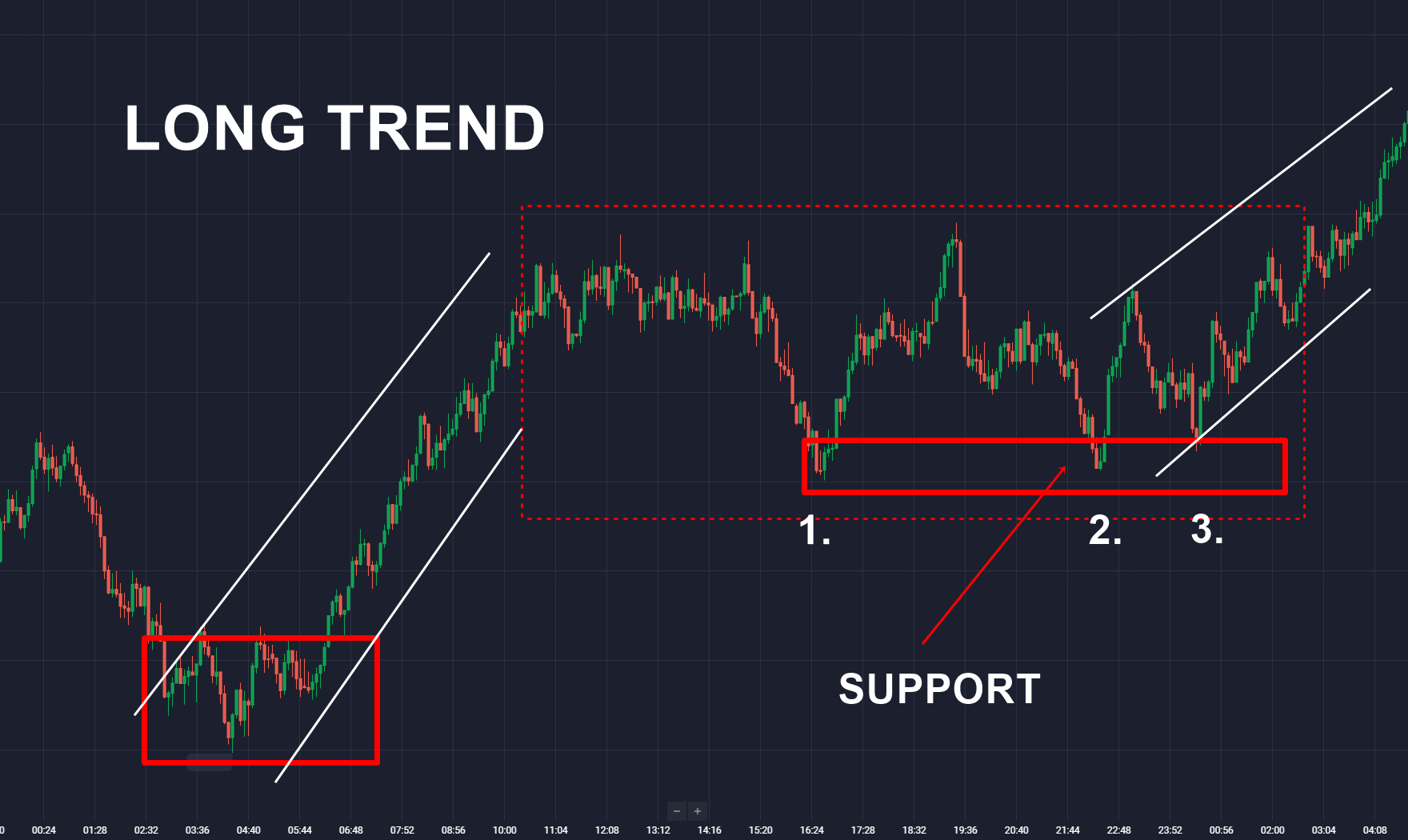2023 온라인 바이너리 옵션 거래로 성공하는 방법
Binaryoptions.com는 10년 이상의 온라인 거래 경험을 바탕으로 거래에 대한 최고의 교육을 제공하며 다음과 같이 도와드립니다.
- 거래 신호 및 로봇에 대한 사기 방지
- 전략
- 초보자를 위한 가이드
- 전문가의 거래 지식
- 거래를 위한 최고의 중개인
- 거래 플랫폼 리뷰 및 팁








바이너리 옵션이란 무엇입니까? - 정의
바이너리 옵션은 결과가 두 가지 다른 옵션을 기반으로 하는 "All-Or-Nothing" 옵션으로 알려진 금융 상품입니다. 높은 수익을 얻거나 투자 금액을 잃을 수 있습니다. 간단한 "예 또는 아니오" 옵션이므로 "바이너리"라고 합니다.
증권 거래소의 현재 가격이 만료 시간 내에 오르거나 내릴 것이라고 제안합니다. 특정 기간에 맞다면 중개인이 정한 금전적 금액을 얻습니다. 거래자는 브로커 플랫폼에서 기간(만료 시간)을 선택할 수 있습니다. 30초 기간에서 최대 2개월 또는 그 이상까지 옵션 거래가 가능합니다. 만기 시간이 끝날 때 가격이 파업 가격보다 높거나 낮은 경우에만 중요합니다.
중요한 사실:
- 이진 옵션에는 승리 또는 패배 결과만 있습니다.
- 거래자는 브로커의 제안에 따라 높은 수익을 얻을 수 있습니다.
- 바이너리 옵션은 정해진 만료 시간 후에 만료되며 그 직후 결과를 보여줍니다.
- 전체 투자 금액으로 인해 위험이 제한됩니다.
- 바이너리 옵션은 미국에서 규제되지만 다른 국가에서는 주로 해외에서 거래됩니다.
여기에서 바이너리 옵션의 기능을 사용해 보십시오.
바이너리 옵션은 다른 거래자 간의 주문을 일치시키는 OTC(장외) 중개인이 제공합니다.
투자금액은 최소 $1부터 최대 $1,000까지 가능합니다. 이는 거래하는 플랫폼에 따라 다릅니다.
바이너리 거래의 초보자라도 무료 데모 계정으로 시작하는 것이 좋습니다. 즉, 가상 화폐로 거래하고 있으며 시장에서 실제 돈을 위험에 빠뜨리지 않습니다.
거래 예시:
거래를 시작하려면 다음 단계를 따르세요.
- 거래하려는 자산을 선택하십시오
- 미래 가격 움직임(위 또는 아래)을 예측합니다.
- 옵션의 만료 시간을 선택하십시오
- 거래에 대한 투자 금액 선택($1부터 시작)
- 거래를 시작하고 행사 가격으로 시장에 진입하십시오.
- 만료 시간이 끝나고 바이너리 옵션이 만료될 때까지 기다리십시오.
- 가격은 행사가보다 높거나 낮아야 합니다(거래 방향에 따라 다름)
- 최대 100%의 수익을 올리거나 투자 금액을 잃습니다.
또한, 우리의 거래 방법에 대한 전체 가이드!
회사 소개 – Binaryoptions.com
바이너리 옵션은 고위험 투자 그것은 초보자와 전문 거래자에게도 잘 알려져 있습니다. 이익이나 손실을 얻기 위해 시장에 베팅하는 한 형태입니다.
짧은 기간에 돈을 벌 수 있는 아주 좋은 방법이기 때문에 10년 넘게 우리는 이 금융 상품을 거래하고 사랑해 왔습니다. 금융 상품의 구조를 통해 우리는 특별한 전략을 사용하고, 웹 사이트에서 보여줍니다.
우리는 대중이 더 성공적인 거래를 이해하도록 돕고자 하는 숙련된 거래자, 분석가 및 콘텐츠 작가입니다. 인터넷에는 이에 대한 허위 및 가짜 뉴스가 너무 많습니다. 우리 페이지에서는 바이너리 옵션 거래에서 손실, 사기 및 허위 정보에 대해 "아니오"라고 말하고 싶습니다.
과거의 경험과 실수에서 더 많은 것을 배우십시오. 바이너리 거래에서 더 많은 성공을 거두는 방법을 투명하게 보여드리겠습니다.

우리를 신뢰할 수 있는 이유
독자들이 정확한 정보와 최고의 지식을 얻을 수 있도록 하려면 어떻게 해야 합니까? – 편집팀과 함께 엄격한 기준으로 작업하고 있습니다. 편집 지침. 우리가 게시한 모든 기사는 실제 거래 전문가에 의해 재차 확인되고 사실이 입증되었습니다. 브로커를 검토하고 비교하기 위해 우리는 다음을 따릅니다. 검토 방법론. 플랫폼은 독자에게 안전한 거래 경험을 제공하는 데 중요한 동일한 기준으로 확인됩니다.
우리는 신뢰할 수 있는 브랜드와만 협력합니다 이는 업계에서 수년간 근무한 기간입니다. 브로커는 실제 시장 상황에서 우리 돈으로 테스트됩니다. 그러나 사기 100%를 예방할 수는 없지만 신뢰 점수가 확실히 도움이 될 수 있습니다. 우리는 각 브로커의 신뢰성과 보안 기능을 검토합니다. 또한, 우리는 독자들에게 최고의 제안을 추천하기 위해 해당 규제 기관과 공식 회사 세부 정보를 확인합니다.
최고 등급의 중개인 – 여기에서 거래를 시작하십시오:
그만큼 바이너리 옵션 브로커 트레이더와 금융 시장 사이의 중개자입니다. 이러한 플랫폼을 통해 다양한 시장에서 숏 포지션을 취하거나 롱 포지션을 취할 수 있습니다. 그들 중 일부는 거래할 수 있는 100개의 자산을 제공합니다. 다른 사람들은 거래할 수 있는 500개 이상의 자산을 제공합니다.
인터넷에는 다양한 브로커와 플랫폼이 있습니다. binaryoptions.com에서 우리는 최고의 것을 서로 비교했습니다. 그들은 당신이 $ 10의 작은 최소 예치금과 $ 1의 최소 거래 금액으로 거래를 시작할 수 있도록 합니다. 최대 이익은 제한되지 않습니다.
100개 이상의 시장
- 국제 클라이언트 수락
- 높은 지불금 95%+
- 전문 플랫폼
- 빠른 입금
- 소셜 트레이딩
- 무료 보너스
100개 이상의 시장
- 최소 예금 $10
- $10,000 데모
- 전문 플랫폼
- 최대 95%의 고수익
- 빠른 인출
- 신호
시작하기 전에 데모 계정을 사용해 보십시오.
ㅏ 데모 계정 가상화폐를 이용한 특별한 거래계좌입니다. 즉, 계정 잔액이 실제 돈으로 채워지지 않습니다. 모든 가상 자금은 자신의 돈에 대한 위험 없이 손실될 수 있습니다. 이 계정은 바이너리 거래를 시작하는 가장 좋은 옵션입니다. 먼저 자신의 돈을 위험에 빠뜨리지 말고 데모 계정으로 시작하는 것이 좋습니다. 이진 거래는 때때로 매우 쉬워 보이지만 사실 대부분의 거래자는 돈을 잃습니다.
획득 경험치, 거래 전략을 개발하다, 다양한 시장에 대해 자세히 알아보고 거래 플랫폼에 대한 지식을 얻으려면 먼저 안전을 위해 데모 계정을 사용해야 합니다. 편안하고 가상 화폐로 약간의 수익을 올렸다면 실제 계정 거래를 시작할 수 있습니다.

(위험 경고: 귀하의 자본이 위험에 처할 수 있음)
가장 중요한 용어:
초보자로서 처음 5분 안에 바이너리 옵션을 이해하기 쉽지 않습니다. 이러한 중요한 용어를 읽고 이해할 수 있는 충분한 시간을 가지십시오. 성공의 핵심 수준입니다. 금융 상품과 그 기능을 이해하지 못하면 결국 모든 돈을 잃을 수 있습니다. 다음 섹션에서는 가장 중요한 용어를 보여주고 설명합니다.
- 기초 자산 – 바이너리를 거래하는 시장입니다.
- 만료 시간 – 거래가 만료되면 최종 결과를 받게 됩니다.
- 행사가격 – 구매 또는 판매를 시작한 가격. 이익을 내기 위해서는 가격이 높거나 낮아야 합니다.
- 고정 수익 – 거래에서 얻을 수 있는 가능한 수익
- 콜옵션 – 당신은 상승하는 가격에 투자합니다
- 풋옵션 – 당신은 하락하는 가격에 투자합니다
바이너리 옵션의 기본 자산

기본 시장은 주식, 상품, 암호 화폐, 외환 또는 ETF가 될 수 있습니다. 제공되는 자산은 브로커에 따라 다릅니다. 거래는 이러한 기본 자산에 대한 옵션 계약을 구매하거나 판매합니다. 소매점에서 금을 사는 것과 같은 자산에 대한 실제 투자가 아닙니다. 옵션 계약을 거래하기만 하면 됩니다.
옵션 만료 시간

바이너리 옵션은 항상 고정된 만료 시간에 닫힙니다. 예를 들어 30초, 60초 또는 1개월 단위로 거래할 수 있습니다. 선택한 브로커와 사용 가능한 만료 날짜에 따라 다릅니다. 만료 날짜에 도달하면 기본 자산 가격이 목표 가격보다 높거나 낮아야 합니다.
목표가/행사가

목표 가격은 기본 진입점 또는 행사 가격입니다. 바이너리 옵션을 사거나 팔기 시작하면 행사 가격은 현재 시장 가격입니다. 따라서 타이밍을 잘 잡는 것이 매우 중요합니다. 목표 가격을 0.1포인트 놓치더라도 전체 투자를 잃을 수 있습니다. 그러나 다른 한편으로 당신이 옳다면 높은 수익을 얻을 수 있습니다. 아마도 당신은 다음과 같이 묻습니다. 두 가지 가격 목표를 가질 수 있습니까? – 대답은 간단합니다. 이것은 불가능합니다.
고정 수익

바이너리 옵션에는 브로커가 고정한 고정된 이익 금액이 있습니다. 고정 지불금은 투자 금액의 60%, 70% 또는 심지어 90%가 될 수 있습니다. 그러나 잘못된 거래 결정을 내리면 전체 투자를 잃을 수 있음을 명심하십시오. 결과는 두 가지뿐입니다. 패배하거나 승리합니다. 고정 지불금은 거래하는 기본 시장과 만료 시간에 따라 달라집니다. 때로는 바이너리 옵션 거래의 세 가지 유형의 결과가 있습니다: 시장이 파업 가격에 정확히 도달했을 때 잃거나, 이기거나, 돈을 돌려받습니다.
콜옵션과 풋옵션

바이너리 옵션은 위험이 제한된 단순한 거래 상품입니다. 거래하는 방법은 두 가지뿐입니다. 콜 옵션과 풋 옵션이 있습니다. 콜 옵션은 바이너리 옵션 시장이 제한된 만료 시간 내에 특정 가격 이상으로 상승할 것이라고 말하는 것을 의미합니다. 풋 옵션은 시장이 제한된 만료 시간 내에 특정 가격 아래로 떨어질 것이라고 말하는 것을 의미합니다.
이익을 계산하려면 내부 도구인 이익 계산기를 사용할 수 있습니다.
아래 도구를 사용하여 바이너리 옵션 거래에서 손익을 계산합니다. 투자 금액, 브로커의 수익, 거래에서 지고 따낸 금액을 입력합니다. 그런 다음 거래의 전반적인 결과를 볼 수 있습니다. 자세한 내용은 당사를 방문하십시오. 이익 계산기 페이지.
(위험 경고: 귀하의 자본이 위험에 처할 수 있음)
바이너리 옵션의 장단점:
장점:
- 위험 제한
- 높은 수익 가능
- 단기 및 장기 거래
- 이해하기 쉬운
- 전문 플랫폼 사용 가능
- 헤징에 사용할 수 있습니다.
- 모든 금융 시장에서 사용할 수 있습니다.
단점:
- 중독 될 수 있습니다
- 나쁜 중개 회사가 있습니다.
- 모든 국가에서 사용할 수 있는 것은 아닙니다.
(위험 경고: 귀하의 자본이 위험에 처할 수 있음)
바이너리 옵션은 합법적입니까?
많은 거래자들이 묻습니다. 바이너리 옵션이 합법적인지 아닌지. 이 질문은 규제되고 안전한 온라인 거래에 대해 이야기할 때 필요합니다. 과거에는 업계에 사기꾼이 많았습니다. 많은 규제 당국은 이러한 문제에 대해 경고하고 금융 상품을 더욱 규제하기 시작합니다. 요즘에는 당국의 규제 감독이 있는 거래 플랫폼을 사용하는 것이 중요합니다.
바이너리 옵션은 99% 국가에서 거래하는 것이 완전히 합법입니다. 개인 투자자에게는 다음과 같은 몇 가지 예외가 있습니다.
- 유럽 연합: 소매 상인에게 판매할 수 없습니다.
- 캐나다: 완전 금지
- 이스라엘: 완전 금지
- 호주: 소매업자에게는 허용되지 않습니다.
바이너리 옵션 거래는 합법적입니다:
금융 상품은 투자자 및 소매 거래자를 위해 합법적으로 거래할 수 있습니다. 전문 트레이더도 바이너리 옵션을 거래할 수 있습니다. 거래자는 적합한 브로커에 가입하고 바이너리 거래를 시작할 수 있습니다. 일부 브로커는 규제되지 않습니다. 따라서 규제 기관에서 거래할 수 있는지 확인하고 조심해야 합니다. 대부분의 경우 거래 계좌를 개설하는 것은 합법적입니다.
유럽에서 금지되어 있습니까?
유럽 연합에서는 바이너리 옵션 서비스를 전문 거래자에게만 판매할 수 있습니다. 즉, 유럽의 중개인은 전문 거래자만 받아들일 수 있습니다. 전문 트레이더가 되려면 € 500,000 이상, 높은 거래량 또는 금융 교육이 필요합니다. 이 점 중 2가지를 신청하면 유럽에서 전문 트레이더로 거래할 수 있습니다. 또한 유럽 외부의 브로커와 거래할 수 있지만 규제되지는 않습니다. 대부분의 플랫폼은 키프로스 규제 기관 CySEC 2010~2018년 동안.
미국에서 합법인가요?
바이너리 옵션은 미국의 공식 금융 상품입니다. 미국 시민권자는 거래가 허용되지만 미국의 규제 기관에서 확인하는 규제 중개인과 함께해야 합니다. CFTC(상품 선물 거래 수수료).

그러나 규제되지 않은 브로커에 주의하십시오. 그만큼 FINRA(금융산업 규제당국) 이미 미국 거래자들에게 서비스를 제공하는 규제되지 않은 기관에 대해 경고했습니다. 중개인의 상태를 모르는 경우 FINRA의 중개인 수표를 사용할 수 있습니다. https://brokercheck.finra.org/
미국에서 가장 중요한 규제 기관:
거래 바이너리 옵션은 다음을 통해 미국에서 사용할 수 있습니다. 북미 파생상품 거래소(NADEX). 규제 거래 플랫폼 중 하나입니다. 몇 번의 클릭으로 구매 또는 판매할 수 있습니다.
바이너리 옵션 규정
요즘에는 소수의 규제 바이너리 옵션 브로커. 대부분은 규제되지 않습니다. 다른 국가에서는 다른 규정이 있습니다. 브로커에 가입하기 전에 해당 국가의 규제 상태를 확인해야 합니다. 경험상 대부분의 중개인은 90% 국가의 고객을 받아들입니다. 브로커가 귀하의 국가에서 작동하는지 브로커 웹 사이트에서 확인할 수도 있습니다. 많은 중개인이 해당 국가에서 거래가 허용되지 않으면 고객을 차단하고 있습니다.
바이너리 옵션 거래 플랫폼 및 브로커
바이너리 옵션 거래를 시작하면 많은 인터넷 기반 거래 플랫폼을 찾을 수 있습니다. 하지만 투자를 위해 어떤 것을 선택해야 할까요? 브로커는 기본 자산을 기반으로 금융 상품 거래를 제안합니다. 브로커는 금융 시장과 거래자 사이의 중개자입니다. 소매 거래자에게는 거래 응용 프로그램, 거래 플랫폼, 소프트웨어 및 라이브 차트가 제공됩니다.
다음 핵심 사항은 귀하에게 가장 적합한 브로커를 선택하는 데 도움이 될 것입니다. 바이너리 옵션 거래 회사를 선택하기 전에 다음 질문을 하십시오:
- 거래 플랫폼이 규제됩니까?
- 우리 나라에서 거래 플랫폼이 합법적입니까?
- 브로커가 우리나라에서 서비스를 제공합니까?
- 거래 애플리케이션을 테스트하기 위해 가상 바이너리 계정을 사용할 수 있습니까?
- 최소 보증금은 얼마입니까
- 숨겨진 수수료가 있습니까?
- 입출금 수수료는 얼마입니까?
- 거래 소프트웨어가 내 분석에 적합합니까?
- 얼마나 많은 자산을 거래할 수 있습니까?
- 주요 거래 시간 동안 투자 수익률은 얼마나 높습니까?
- 브로커가 실시간 지원을 제공합니까?
보시다시피, 브로커를 선택하기 전에 물어볼 많은 질문이 있습니다. 바이너리 옵션 브로커 비교에서, 우리는 당신에게 우리의 권장 사항을 보여줍니다.
사기 바이너리 브로커의 방법은 무엇입니까?
사기성 바이너리 옵션 거래 회사는 규제 요구 사항과 일치하지 않습니다. 규제되지 않은 거래 플랫폼이 나쁘다는 의미는 아니지만 대부분의 경우 거래를 시작하는 것은 매우 위험합니다. 투자 여정을 시작하고 회사에 의해 속이는 경우 다음 방법이 일반적입니다.
- 요청 거부: 브로커는 거래를 열거나 닫으라는 귀하의 요청을 거부합니다. 이는 변동성이 큰 바이너리 옵션 시장에서 매우 고통스러울 수 있습니다.
- 자금 반환 없음: 그만큼 바이너리 사기 브로커 귀하의 은행 계좌 또는 지불 방법으로 자금을 반환하지 않습니다.
- 조작된 실시간 차트: 사기성 브로커는 거래를 위한 최고의 차트와 실행을 가지고 있지만 조작되었다고 말합니다.
- 가짜 계정 관리자: 중개인은 돈을 버는 데 도움이 될 수 있는 전문가 팀이 있다고 말할 것입니다. 이 모든 사람들은 당신의 돈만을 원하고 당신의 투자에 대한 좋은 팁을 가지고 있지 않습니다.
- 숨겨진 수수료: 중개인은 예를 들어 돈을 인출하려고 할 때 엄청난 양의 수수료를 청구할 것입니다.
- 조작된 거래: 바이너리 브로커는 당신의 이기는 거래를 조작하고 그것을 잃는 거래로 바꿀 것입니다.
성공을 위한 반복 전략 수립
전문 거래자에게 시장 거래 방법을 묻는다면 그는 시장에 진입하고 빠져나가는 규칙과 전략을 따르고 있다고 말할 것입니다. 장기적으로 돈을 벌기 위해서는 바이너리 옵션 전략이 필요합니다. 예, 시장에서 운이 좋다면 계획 없이도 수익성 있는 거래를 할 수 있지만 장기적으로는 제대로 작동하는 전략이 필요합니다!

시장에서 작동하는 많은 거래 전략이 있습니다. 여기서 가장 중요한 점은 규칙 집합을 기계처럼 실행하는 것입니다. 종종 트레이더는 자신의 규칙에 따라 거래하지 않으며 이로 인해 손실이 발생합니다. 위의 예에서 가격 조치와 촛대 차트로 시장을 분석한 것을 볼 수 있습니다. 우리는 시장이 더 높은 가격을 밀어붙이는 것을 분명히 봅니다. 시장은 저점을 낮추지 않으므로 우리는 추세에 따라 거래하고 여기에서 일부 롱 포지션을 생성하기를 원합니다.
전략에는 다음 사항이 포함되어야 합니다.
- 현재 시장은 어디에 있습니까?
- 시장의 마지막 움직임은 무엇입니까?
- 추세나 범위를 볼 수 있습니까?
- 최고점과 최저점은 어디에 있습니까?
- 거래를 입력하라는 확인 메시지가 표시됩니까?
더 자세한 지식과 학습을 원하시면 당사를 방문하십시오. 전략 페이지.
투자자에게 가장 큰 위험은 무엇입니까?
전에 언급했듯이, 바이너리 옵션 거래는 매우 위험합니다. 초보자는 종종 거래자가 몇 초 만에 수천 달러를 버는 YouTube 동영상에 깊은 인상을 받습니다. 그들이 보지 못하는 것은 YouTube나 다른 플랫폼에 나타나는 거래자들이 경험이 있고 그들이 무엇을 하는지 알고 있다는 것입니다. 당신은 그들의 거래 전략을 따라할 수 있지만, 시장에서의 경험 부족으로 인해 결국 돈을 벌지는 못할 것입니다.
바이너리 옵션을 거래하는 동안 전체 투자 금액을 잃을 수 있습니다. 이것은 초보자가 거래를 시작하는 것을 볼 때 가장 과소평가된 위험입니다. 브로커 웹사이트에서 90%+의 수익을 얻을 수 있다는 것이 좋은 것 같습니다. 하지만 틀리면 100% 손실이 발생합니다. 투자자를 위한 바이너리 옵션의 위험 보상 비율에는 항상 불리한 점이 있습니다. 따라서 지속적인 돈을 벌기 위해서는 55% – 60% 또는 70% 이상의 승리 거래가 필요합니다.
아래 표를 참조하십시오.
| 바이너리 옵션의 평균 수익: | 돈을 벌기 위한 최소 거래 승리(손익분기점보다 약간 높음): | 승률: |
|---|---|---|
| 90% | 100명 중 최소 53명의 승자 | 53%+ |
| 80% | 100점 만점에 최소 56점 | 56%+ |
| 70% | 100점 만점에 최소 59점 | 59%+ |
| 60% | 100점 만점에 최소 63점 | 63%+ |
계산에서 볼 수 있듯이 손익분기점을 달성하려면 최소한 53% – 56%의 승률이 필요합니다(평균 수익률 80% – 90%로 측정). 더 많은 돈을 벌려면 최소 60% – 70%의 승률이 필요합니다. 수익에 영향을 미치는 다양한 요소가 있습니다.
- 기초 자산의 수익률
- 거래의 승률
- 바이너리 옵션에 마팅게일 전략을 사용합니까?
마틴게일 시스템 또는 더블업 바이너리 전략에 대한 높은 위험
많은 초보자들이 사용하고 있는 마틴게일 제도 또는 손실을 복구하기 위한 더블업 전략. 아이디어는 간단하고 도박 현장에서 그 역사를 가지고 있습니다. 내기에서 지면 그냥 투자 금액을 두 배로. 거래할 때 모든 손실을 복구하려면 두 배 이상의 돈을 투자해야 합니다. 아래 계산은 예를 보여줍니다.
더블업 전략 계정 크기는 $ 10.000이고 위험 관리는 1%입니다. 5번의 거래 실패 후 계정이 파산하여 이 전략을 계속할 수 없습니다.
| 계정 크기: | 거래 손실: | 투자(2배) | 이익(80% 평균): | 순이익(승리한 경우): |
|---|---|---|---|---|
| $ 9,900 | 1. | $ 100 | $ 80 | $ 80 |
| $ 9,700 | 2. | $ 200 | $ 160 | $ 60 |
| $ 9,300 | 3. | $ 400 | $ 320 | $ 20 |
| $ 8,500 | 4. | $ 800 | $ 640 | – $ 60 |
| $ 6,900 | 5. | $ 1600 | $ 1280 | – $ 220 |
| $ 3,700 | 6. | § 3200 | $ 2560 | – $ 540 |
마틴게일 전략 계정 크기는 $ 10,000이고 위험 관리는 1%입니다. 5번의 거래 실패 후 귀하의 계정은 파산하고 이 전략을 계속할 수 없습니다.
| 계정 크기: | 거래 손실: | 투자(2,3배) | 이익(80% 평균): | 순이익(승리한 경우): |
|---|---|---|---|---|
| $ 9,900 | 1. | $ 100 | $ 80 | $ 80 |
| $ 9,670 | 2. | $ 230 | $ 184 | $ 84 |
| $ 9,141 | 3. | $ 529 | $ 423 | $ 93 |
| $ 7,925 | 4. | $ 1216 | $ 972 | $ 113 |
| $ 5,129 | 5. | $ 2796 | $ 2236 | $ 160 |
| – $ 1,301 | 6. | $ 6430 | $ 2144 | $ 273 |
거래 계정을 빨리 죽일 수 있기 때문에 이러한 전략을 사용하지 않는 것이 좋습니다! 위에서 보시는 것처럼 연속으로 5번의 손실 거래를 할 수 있으며, 계정 잔액의 1%만 가지고 시작하더라도 계정이 사라집니다. 좋은 위험 관리를 배우고 전문 거래자와 같은 투자에 고정 금액을 사용하십시오.
감정과 도박
바이너리 거래의 또 다른 높은 위험은 감정과 심리입니다. 온라인 거래는 때때로 초보자를 위해 카지노에 가는 것과 같습니다. 당신은 이기거나 질 수 있습니다! 너무 많은 돈을 잃거나 너무 많은 거래를 연속으로 잃으면 트레이더는 모든 손실을 복구하기를 원하기 때문에 비합리적인 거래 결정을 내리는 경향이 있습니다. 우리의 경험에 비추어 볼 때 초보자가 자신이 그렇게 빨리 돈을 잃었다는 것을 믿을 수 없기 때문에 자신의 계정을 죽이기 시작하는 일이 발생할 수 있습니다. 종종 많은 거래와 대량 거래가 이루어집니다. 손실을 받아들이고 거래 계획을 계속 사용하는 방법을 배우십시오!
손실 위험에 대한 솔루션: 거래 계획
거래를 관리하는 엄격한 거래 계획을 세우십시오. 거래 계획을 사용하면 다음 사실을 고려해야 합니다.
- 자산 관리
- 무역 진입
- 무역 출구
- 거래 만료 시간
- 적절한 투자 금액
- 시장 뉴스에 주목
- 바이너리 옵션 거래 전략을 고수하십시오.
감정을 줄이는 가장 좋은 방법은 규칙이 있는 거래 계획을 세우는 것입니다. 여기에는 적절한 전략도 포함됩니다. 예를 들어 기간 50의 SMA와 기간 20의 EMA가 교차하고 있고 RSI 지표가 과매도/과매수 상태라고 하면 거래를 시작하고 돈을 투자합니다. 차트에서 이 설정을 보지 않으면 거래를 입력하지 않습니다. 이것은 단순한 예일 뿐이며 더 많은 규칙을 추가할 수 있습니다.
주제 개요:
가장 많이 묻는 질문:
바이너리 옵션은 언제 사용할 수 있습니까?
바이너리 옵션은 변동성이 높거나 변동성이 낮은 시장에서도 사용할 수 있습니다. 바이너리 옵션이 돈을 벌거나 기존 포트폴리오를 헤징하는 데 사용되는 대부분의 경우. 소매 투자자는 종종 이 금융 상품을 사용하여 단기적으로 이익을 얻습니다. 전문 트레이더는 이 금융 상품을 사용하여 투자자의 계정을 헤지합니다.
바이너리 옵션은 사기입니까?
바이너리 옵션은 사기가 아닙니다. 공식적으로 규제되는 금융 상품입니다. 불행히도 규제상의 이유로 많은 국가에서 사용할 수 없습니다. 경험이 풍부하고 잘 알려진 브로커를 선택하면 바이너리 옵션에 투자할 수 있습니다.
바이너리 옵션을 거래하여 부자가 될 수 있습니까?
그것은 "부자"의 정의에 달려 있습니다. 당신은 할 수 있습니다 바이너리 옵션 거래로 많은 돈을 버십시오, 그러나 다른 한편으로는 시장을 거래하는 것은 매우 위험한 방법입니다. 대부분의 트레이더는 거래를 시작할 때 위험을 과소평가합니다. 돈을 벌기 위해서는 적절한 거래 전략과 경험이 필요합니다.
바이너리 옵션에 대한 경고가 많은 이유는 무엇입니까?
예전에는 이 시장에 가짜 웹사이트나 가짜 가격표를 이용해 초보자의 돈을 훔치는 사기꾼이 많았습니다. 규제 당국은 이에 대해 경고하고 금융 상품의 거래를 금지하기 시작했습니다. 바이너리 옵션을 거래할 때 선택하는 것은 매우 위험한 투자 기회입니다. 투자한 돈을 모두 잃을 수 있음을 명심하십시오!
(위험 경고: 귀하의 자본이 위험에 처할 수 있음)
YouTube의 최신 거래 동영상











![Pocket Option 튜토리얼 [ FULL TRADING GUIDE ] 📈 초보자를 위한 올바른 사용법](jpg/mqdefault-12.jpg)













































































거래 커뮤니티의 의견
조던 피터스
바이너리 옵션 거래자
훌륭한 비교 사이트. Binaryaoptions.com은 제 투자에 가장 적합한 바이너리 브로커를 보여주었습니다. 저는 지금 이전 브로커보다 20% 더 높은 수익률로 거래합니다.
안드레아 월벳
바이너리 옵션 투자자
이 웹사이트에 대한 훌륭한 정보를 주셔서 감사합니다! 당신 덕분에 거래 전략이 향상되었습니다.
존 뮬러
바이너리 옵션 거래자